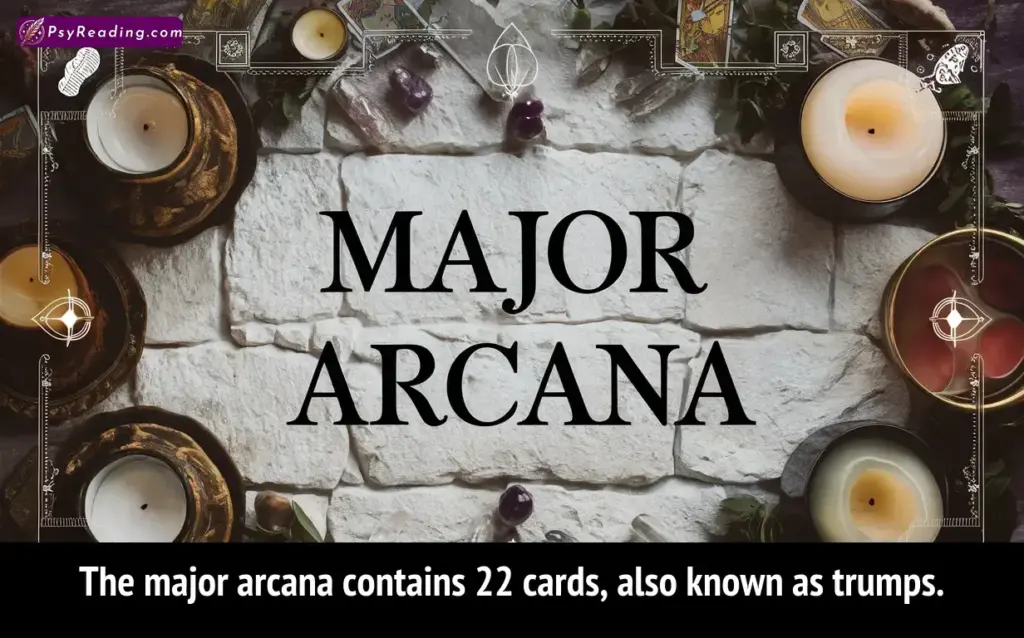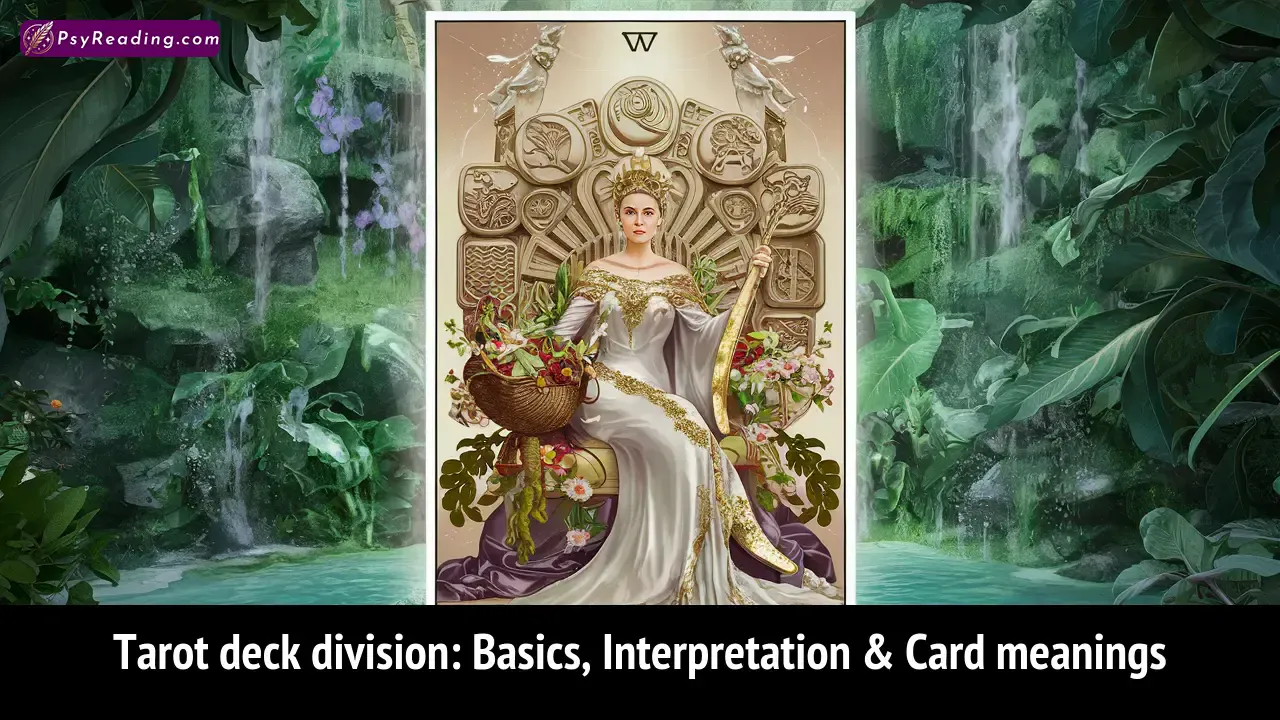The Tarot deck has 78 cards divided into Major and Minor Arcana, each offering unique perspectives on life. Major Arcana cards reveal deep, transformative themes, while Minor Arcana cards focus on day-to-day matters. Below, discover core questions about Tarot divisions, their significance, and how they enhance spiritual or practical readings.
Contents
- 1 What are the Basic Tarot Card Divisions?
- 2 How are Tarot Card Divisions Interpreted?
- 3 Where can I find a list of cards from both Tarot Card Divisions?
- 4 What is the Significance of Tarot Card Divisions?
- 5 What is the Major Arcana Tarot Card Division?
- 6 What is the Minor Arcana Tarot Card Division?
- 7 How do Tarot Card Divisions Influence a Reading?
- 8 What is the Relationship Between Tarot Card Divisions and Astrology?
- 9 How do Tarot Card Divisions Relate to Numerology?
- 10 How to Use Tarot Card Divisions for Personal Growth?
- 11 What are the Ethical Considerations in Using Tarot Card Divisions?
- 12 What is the Role of Intuition in Interpreting Tarot Card Divisions?
- 13 How are Tarot Card Divisions Used in Meditation and Mindfulness Practices?
- 14 What are the Similarities Across Different Tarot Card Divisions?
What are the Basic Tarot Card Divisions?
The Tarot’s basic divisions are the Major Arcana (22 cards) and Minor Arcana (56 cards). Major Arcana deals with transformative life lessons, while Minor Arcana addresses everyday issues. Knowing these divisions helps you interpret readings more accurately, linking broader lessons with practical, real-world experiences.
How are Tarot Card Divisions Interpreted?
They’re interpreted by evaluating each card’s theme and context within a spread. Major Arcana highlights pivotal life moments or karmic lessons, while Minor Arcana delves into daily challenges and actions. Combining both divisions paints a clearer narrative, revealing where significant changes or smaller shifts may emerge.
Where can I find a list of cards from both Tarot Card Divisions?
You can find a complete list in our “Tarot Cards List with Meanings” article. It catalogs each Major and Minor Arcana card, explaining its symbolism, keywords, and potential influence. This reference is designed for quick printing and easy study for all Tarot enthusiasts.
What is the Significance of Tarot Card Divisions?
They offer layered insights into personal growth and events. Major Arcana focuses on life-changing transformations, while Minor Arcana explores everyday dynamics. Together, they portray the full human experience, from deep spiritual calls to practical, moment-to-moment experiences, helping readers grasp both macro and micro contexts.
What is the Major Arcana Tarot Card Division?
The Major Arcana includes 22 cards, from The Fool (0) to The World (21), signifying significant spiritual lessons or life events. Cards like The Lovers, Death, or Judgment represent crucial turning points. Their appearance often signals profound insights, urging deeper reflection and heightened awareness of pivotal changes.

What is the Minor Arcana Tarot Card Division?
The Minor Arcana’s 56 cards split into four suits: Cups, Pentacles, Swords, and Wands. Each suit addresses life’s daily elements: emotions, finances, intellect, and creativity. These cards clarify immediate challenges or opportunities, complementing the Major Arcana’s grand themes by grounding them in tangible, everyday scenarios.
How do Tarot Card Divisions Influence a Reading?
They enrich a reading by merging overarching life lessons (Major Arcana) with practical details (Minor Arcana). Major cards signal crucial shifts or milestones, while Minor cards highlight immediate steps or concerns. Their interplay guides you toward a holistic interpretation, revealing both destiny-shaping forces and day-to-day actions.
What is the Relationship Between Tarot Card Divisions and Astrology?
Each Tarot division correlates with astrological elements and signs. Major Arcana cards often pair with zodiac signs or planets, reflecting cosmic archetypes. Minor Arcana suits align with Earth, Air, Fire, and Water, mirroring astrological energies in daily life. This union merges celestial insight with practical guidance.
How do Tarot Card Divisions Relate to Numerology?
Numerology weaves into Tarot through card numbering. Major Arcana runs from 0 to 21, each number revealing deeper lessons. Minor Arcana suits feature Ace to 10 and four court cards. Interpreting these numbers—like new beginnings (Ace) or completion (10)—adds another layer of meaning to your reading.
How to Use Tarot Card Divisions for Personal Growth?
Combine Major and Minor Arcana insights to explore big-picture life themes and daily habits. Focus on a key lesson signaled by a Major card, then use Minor cards to outline practical steps. This synergy shows how spiritual evolution can manifest through incremental changes and consistent self-reflection.
What are the Ethical Considerations in Using Tarot Card Divisions?
Ethical readings honor privacy, consent, and transparency. Communicate openly about Tarot’s interpretative nature, never imposing fear or false certainty. Respect boundaries, keep readings confidential, and use the cards as a supportive guide, not a predictive absolute. Ethical practice fosters trust, ensuring Tarot remains empowering and constructive.
What is the Role of Intuition in Interpreting Tarot Card Divisions?
Intuition bridges symbolic meaning and personal insight, helping you sense each card’s energy. Major Arcana prompts deeper inner reflection, while Minor Arcana refines details. By tuning into intuitive nudges, you fuse traditional definitions with your unique perception, creating readings that resonate more genuinely with each seeker’s life.
How are Tarot Card Divisions Used in Meditation and Mindfulness Practices?
They serve as focal points for self-awareness. Pick a Major Arcana card to contemplate transformative themes, or a Minor Arcana card to spotlight everyday stressors or motivations. Reflecting on artwork and symbolism during meditation cultivates clarity, helping you integrate Tarot’s lessons into mindful, purposeful living.
What are the Similarities Across Different Tarot Card Divisions?
All divisions explore aspects of the human journey, from grand spiritual awakenings (Major Arcana) to practical, routine concerns (Minor Arcana). Despite their focus differences, each card mirrors universal truths about growth, conflict, and connection. They share a unifying goal: illuminating life’s path through symbolism, intuition, and introspection.


Great overview… thanks. What are some of your favorite tarot deck?
Thank you for your lovely comment!
When it comes to my favorite decks, I have to say the Magpie Deck and Love are wonderful for their intuitive feel, while the Thoth and Crowley Thoth decks for their profound, esoteric insights. Each deck adds a unique layer to my readings, enhancing my practice in different ways. I’m curious to hear about others’ favorite decks?
Personally, I just go with my old deck A.E. Waite Tarot Standard Blue